By James (Jim) M. Ryan
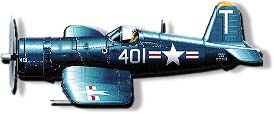 My time
with VF-l4 was from about 1953 to 1955. When I first joined the squadron they had just
returned from a Med Cruise and were still flying the F4U's (or FG1 D's of Goodyear). At
that time the squadron was based at Cecil Field, Florida, which was like "old home
week" for me. My father had been the Senior Dental Officer (Commander A. J. Ryan) at
Cecil during WWII and I spent much time there as a "Navy Brat", along with Pete
Bagdanovich, the CO's son. My time
with VF-l4 was from about 1953 to 1955. When I first joined the squadron they had just
returned from a Med Cruise and were still flying the F4U's (or FG1 D's of Goodyear). At
that time the squadron was based at Cecil Field, Florida, which was like "old home
week" for me. My father had been the Senior Dental Officer (Commander A. J. Ryan) at
Cecil during WWII and I spent much time there as a "Navy Brat", along with Pete
Bagdanovich, the CO's son.
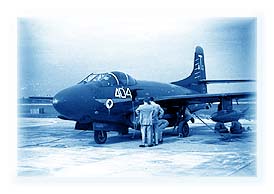 I recall an incident just
after I joined the squadron where a mechanic had coupled the hydraulic lines backwards to
the gear retraction system on an F4U. When the pilot took off and retracted the gear, one
gear cycled up and the other remained extended! When he cycled the gear again they
reversed and remained one up, one down. I recall an incident just
after I joined the squadron where a mechanic had coupled the hydraulic lines backwards to
the gear retraction system on an F4U. When the pilot took off and retracted the gear, one
gear cycled up and the other remained extended! When he cycled the gear again they
reversed and remained one up, one down.
The East/West runway at NZC (N.A.S. Cecil Field, Fla.) was prepared for an emergency
landing and an arresting wire was strung over the runway with anchor chains deployed down
runway so that when the wire was engaged it would pick up the wire and the leading end of
the chain. The pilot made a beautiful "two-point" landing and engaged the wire
just as he flared out. As the plane continued down the runway, picking up more & more
anchor chain as it went, it slowed quickly. He held the left wing up as long as he could
(the one with the retracted gear) and at the last moment dropped off on the left SCAR
(rocket) rails and extended left flaps. It was beautiful!
Damage to the plane was minimal with only the rails, flaps and prop tips bent. They
replaced these and the aircraft was placed back in service. I believe the pilot received a
commendation in his service jacket.
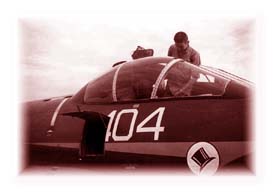 Shortly thereafter our new
(read "well used") F3D's arrived and we began our transition to the pure jets.
The F3D was a good transition aircraft, but terribly "pokey". It was extremely
under powered with the J-34 engines and, as written up by the Marines in Naval Aviation
News, the only way you could break Mach I was in a long dive at full power! They also
noted control reversal after exceeding Mach I, which was disconcerting to say the least. Shortly thereafter our new
(read "well used") F3D's arrived and we began our transition to the pure jets.
The F3D was a good transition aircraft, but terribly "pokey". It was extremely
under powered with the J-34 engines and, as written up by the Marines in Naval Aviation
News, the only way you could break Mach I was in a long dive at full power! They also
noted control reversal after exceeding Mach I, which was disconcerting to say the least.
Duty at NZC consisted of many FAM (Familiarization) hops to favored destinations; one of
ours was NGU (N.A.S. Glenview, lllinois), when we got a chance to go home for several
days. The enclosed photos were taken at the conclusion of one of these FAM hops with Lt.
Hal Brooks and myself. On this flight we experienced a double flame-out over Barksdale AFB
Louisiana trying to maintain VFR on top at 34,000'! Needless to say we had both approached
the "apogee of concern" before we got a successful air-start. This explains the
slightly "peak-ed" look on our faces.
Other local hops included gunnery practice with the "duty aircraft" towing the
target and the remaining aircraft practicing intercepts. Although the F3D had four 20mm
cannon (mounted in the "chin" of the aircraft, behind the radome) we only used
two in practice. Ordnance crews applied colored, oil based paint to the nose of the belted
20mm ammunition. This allowed us to view the recovered banner and count the hits of each
pilot by their designated color. Naturally there was a lot of good natured ribbing about
this and occasionally a pilot would get "sucked in" behind the target so far
that the rounds would be
deflected toward the tow aircraft, rather than penetrating the banner cleanly. The pilot
so identified would then be scheduled to tow the next banner!
When a pilot was unable to score any hits at all, it was common to "squawk" the
gun sight as being "mis-aligned". When bore-sighted the guns would be right on.
On occasion this was written up as "a short circuit between the stick and the
seat"!
I recall being on a recovery team to pick up one of the gunnery banners that was released
prematurely into the "boon-docks" south of the base, that took us into some very
rough scrub county. We accidentally stumbled onto a "moonshine still" in full
operation! Needless to say, we didn't waste any time getting out of there before someone
mistook us for "revenooers".
Because of the configuration of the radar nose housing, and the location of the cannon, it
was necessary to add barrel extensions to the 20mm's to extend the bullet path beyond the
radome. On one occasion the ordnance crew had gone back to the hanger for a web wrench to
tighten the barrel extensions on the guns, but the plane was put into service for a
gunnery hop before they could complete the operation. A slight design flaw caused the
external barrel threads to be opposite the rifling in the gun barrels. Thus, on the hop,
when the first few rounds were fired the barrel extensions were unscrewed and dropped down
a few inches in the tunnels. Then the next rounds struck the top of the deflected
gun barrel extensions, causing them to ricochet up into the radome housing and completely
blowing off the fiberglass radome cover! The first incident on record of a pilot shooting
himself down! (He returned safely, despite the "flat" nose of the radar bay.)
Another nifty feature of the F3D was the gear retraction mechanism, which included a
detent pin that protruded into the path of the gear lever and prevented premature
retraction while on the ground. The detent pin was controlled by a micro-switch on the
main gear so that when the weight came off the gear the micro-switch would open and permit
the detent pin to retract out of the way.
Some times a "hot" pilot would pull the gear lever hard against the detent pin,
so that as soon as the weight came off the struts the pin would retract and the wheels
would retract instantly. We had at least one incident when we suspect this happened as the
aircraft hit the rise in asphalt at the runway intersections, and instead of being truly
airborne the plane was only hitting a bump. Without adequate flying speed it quickly
settled back onto the runway, only now the gear was up! Off the end of the runway; and it
removed several hundred feet of chain link fence to go with it!
One of our neat TAD adventures was a tour at Patuxent River, Maryland outside of
Washington, DC to give FAM hops to the "Middies" at Annapolis, to try and induce
them to join Naval Aviation upon graduation. Unfortunately some of the pilots took delight
in seeing how sick they could make the "Middies" with plenty of maneuvers!
One of these pilots got himself caught however when executing an excessively low level run
up the Potomac River. He didn't see the high tension lines until it was too late and
proceeded to scrape off the radome, both engine housings and collected about 100' feet of
high tension line with his tail hook! Embarrassing to say the least, and certainly
difficult to deny, with the wire dangling behind the plane!
But our most memorable adventure was our tour on the U.S.S. Intrepid to test
Westinghouse's new steam catapults. Because of the configuration of the F3D, and its bulky
weight, I guess they thought if they could successfully throw us off the deck they could
throw anything!
We flew the squadron to Norfolk and put the aircraft onboard the carrier with the hook.
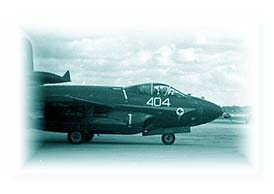 One small flaw however,
placed a vent in the forward end of the steam track. When we prepared the launch, the
first aircraft went off with little or no problem. On the second launch, condensed steam
from the previous shot (read "water") spouted out the vent. With the very low,
underslung engine mounts on the F3D the water spout went directly into the engine intake
and flamed out the starboard engine. The pilot continued to climb out O.K. On the third
aircraft however, the collected water went into both intakes causing a double flame out!
This dropped the plane directly into the water. The carrier skipper issued an emergency
full hard right turn and was able to miss the downed plane. I can't remember who the pilot
was on this shot but I know he was quick! I swear that he was out of the cockpit and on
top of the plane waiting for the helicopter pickup even before the splash came down! That
aircraft was side number 404, which is the one shown in the accompanying pictures. One small flaw however,
placed a vent in the forward end of the steam track. When we prepared the launch, the
first aircraft went off with little or no problem. On the second launch, condensed steam
from the previous shot (read "water") spouted out the vent. With the very low,
underslung engine mounts on the F3D the water spout went directly into the engine intake
and flamed out the starboard engine. The pilot continued to climb out O.K. On the third
aircraft however, the collected water went into both intakes causing a double flame out!
This dropped the plane directly into the water. The carrier skipper issued an emergency
full hard right turn and was able to miss the downed plane. I can't remember who the pilot
was on this shot but I know he was quick! I swear that he was out of the cockpit and on
top of the plane waiting for the helicopter pickup even before the splash came down! That
aircraft was side number 404, which is the one shown in the accompanying pictures.
Capt. Russell "Rusty" Trudeau was our C.O. at the time and he immediately ceased
all flight operations and called a halt to the exercise. We steamed back to Norfolk
intending to unload. But just as we were approaching the James River we got the alert on
approaching Hurricane Hazel (which you will recall as one of the most disastrous
hurricanes to hit the east coast) and we promptly put about and steamed 300-400 miles back
out to sea to ride out the storm.
An interesting side light, I can remember standing at the aft end of the flight deck
during those high seas and watching the ship actually bend in the middle at the expansion
joint as it crested those high waves! It was quite a sight!
We returned to Cecil Field and shortly before the squadron departed for another cruise I
was transferred TDY to Mainside to the PIO (Public Information Office) and worked under
Capt. Casey Zane for the rest of my tour, as Editor of the "Jax Air News", our 8
page service weekly.
I returned to civilian life in 1955 to the Chicago area and began my business career.
After working at Allied Radio for several years I went into the Rep business in
electronics (I also had a background in Ham Radio and served as the Net Operator for the
Florida Tropical Phone Net - Hurricane Net while at Cecil as W4SGH; "We 4 Sure Get
Hot in Florida.")
I relocated to Dallas in 1962 as Manager of the Communications of Texas Research &
Electronics and later that year started Ryan Associates as a Management Consulting firm in
high-tech businesses. Since that time I have been instrumental in the development of the
Cellular Telephone system, speed Radar Detection devices, communications equipment, and
now an extensive business supplying bundled, tum-key computer systems for small
businesses.
I also was able to return to my first love, flying, as a consultant for Mooney Aircraft
out of Kerrville, Texas and eventually owned (with partners) a small, hip-pocket company
with 4 aircraft in a lease/rental activity. I got my civilian ticket with ASEL instrument
ratings and accumulated almost 3,OOO hours of civilian P/I/C time. It's been a lot of fun!
During a business trip to Virginia Beach recently I was able to make a contact with the
squadron through Lt. Bill Paisley who was a RIO flying the F-l4 Tomcat's. I got an
opportunity to tour the VF-l4 facilities and actually get a close look at the Tomcat. It
looks like quite a plane!
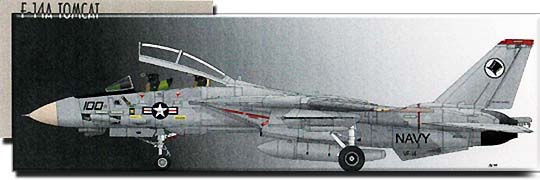
On that trip I saw in the Ready Room that they had pictures of all
the VF-l4 aircraft, even from the early days, in VF-l4 colors, EXCEPT the F3D. I prepared
a presentation of these photos of mine for them to add to the Ready Room gallery.
In corresponding with Bill I learned that he was close to that Libyan "shoot"
that took place recently. He was in a flight of 3 aircraft that immediately preceded the 3
Tomcat's that actually shot down the Libyan Migs. The video tapes (especially the sound)
of the shoot were outstanding!
Cdr. Russ Trudeau now lives in nearby Ft. Worth and we have talked by phone. I hope we get
a chance to get together soon and reminisce about VF-14. I have not been able to relocate
my log book recently, although I know it's here somewhere, and hope to resurrect some of
the names, dates, and incidents from that. I would like to extend my "greetings"
to all "Top Hatters" and hope someday to renew acquaintances at a possible
reunion.
Sincerely,
James M.Ryan
P.O. Box 867057
Plano, Texas 75086
(972) 596-8411
 (Note: this squadron recap was compiled for
Tom Gates, author of Fighter Squadron Fourteen "Tophatters" published by
Squadron/Signal Publications, located at 1115 Crowley Dr., Carrollton, Texas 75011.
Excerpts and photos were used in that publication. JMR) (Note: this squadron recap was compiled for
Tom Gates, author of Fighter Squadron Fourteen "Tophatters" published by
Squadron/Signal Publications, located at 1115 Crowley Dr., Carrollton, Texas 75011.
Excerpts and photos were used in that publication. JMR)
Related links on this site:
Alumni Photos Page 2, The Alumni Pages,
Squadron History, VF-14
Aircraft History, F-14A Tomcat
You ca download large format pictures of the
F3D here:
404 parked(184kB), 404
cockpit(162kB), 404 taxi(96kB) |